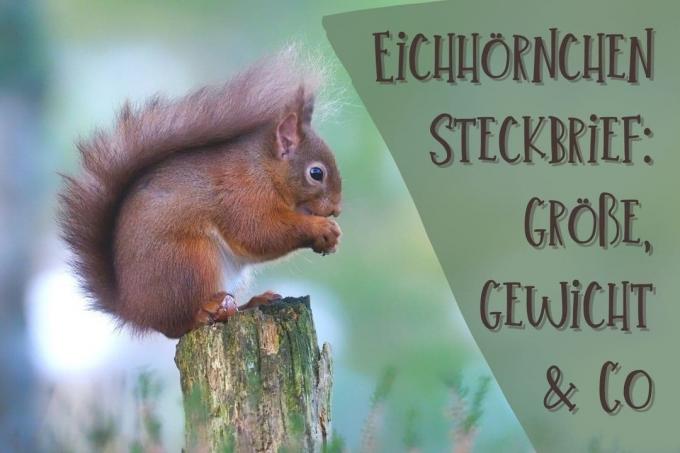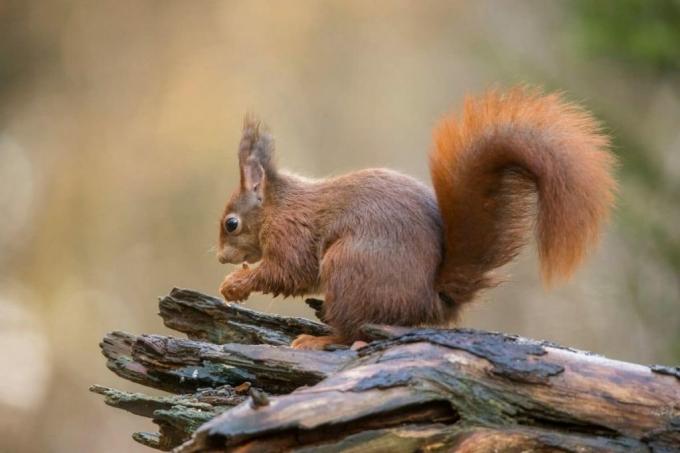
table of contents
- Overview of facts
- Perfect fit
- way of life
- Reproduction
- Do squirrels hibernate?
- frequently asked Questions
Squirrels often live as cultural followers in urban parks and gardens, where they can be seen busily foraging. Read more interesting facts about the cute rodent in our profile.
In a nutshell
- tree-dwelling rodent widespread in Europe
- primarily native to forests with old trees, also in parks and gardens
- characteristic is dense, red-brown fur and the body-length, bushy tail
- lives solitary
- does not hibernate and must therefore stock up
Overview of facts
- Scientific name: Sciurus vulgaris
- Family: Squirrel (Sciuridae)
- Order: Rodents (Rodentia)
- Class: Mammals (Mammalia)
- Distribution: Europe and Asia
- Habitat: deciduous, coniferous and mixed forests with old trees, urban parks and large gardens
- Size: between 20 and 25 centimeters
- Weight: between 200 and 400 grams
- Age: up to 10 years
- Appearance: thick, reddish to blackish fur, up to 25 centimeters long, bushy tail, brush ears
- Food: Omnivores, especially nuts, seeds and fruits, but also insects, eggs and young birds
- Enemies: birds of prey, smaller predators such as martens, weasels, domestic cats
- Social behavior: loner
- Critically endangered: no

Perfect fit
As tree dwellers, squirrels are perfectly adapted to their habitat - sometimes they seem busy Animals override any law of nature when they nimble up the trunks and upside down again rush down. This is made possible by the disproportionately long and very muscular hind legs, which also enable the animals to make long leaps from branch to branch. There are also long, flexible grasping toes with sharp claws on the front and rear paws, with which the squirrels can effortlessly climb up and down even on smooth trunks.
Another species-typical adaptation concerns the body-length, bushy tail:
- helps with jumping and climbing
- important for balance
- serves as a rudder when gliding from branch to branch
- the animal can warm itself and its young with its tail
The color of their fur also helps the squirrels to adapt perfectly to their environment. Animals living in coniferous forests are often blackish instead of red-brown in color. The winter coat is also darker than in summer.
Note: Furthermore, squirrels use their tails to communicate with other members of their own species. A sideways tail wag means that the animal is excited and nervous.
way of life

Squirrels are diurnal and eagerly forage during the day. At night the rodents sleep in so-called Kobeln, as their spherical, downwardly open nests are called. These are high up and well hidden in the canopy of old trees. A squirrel usually builds several of these goblins from twigs and soft materials that are in different places and are changed from time to time. In this way the animal wants to evade enemies. Each Kobel has at least two entrances so that the squirrel can flee quickly in case of danger. Squirrels are decidedly loners who only meet with others of their kind during the mating season.
Reproduction
The mating season begins very early in the year and is characterized by wild chases through the trees, with several males often chasing a female. When the mating takes place depends, among other things, on the severity of winter and the amount of food available. In very cold winters and / or with little food, it can shift into summer, so that the first litter of young squirrels is not born until July or August. In good years, however, mating occurs as early as the end of January.
- Gestation takes approx. four weeks
- two to six young per litter
- are initially still naked and blind
- Father not involved in rearing
- Squirrel babies develop very quickly
- only stay in the nest for around eight weeks
- are then looked after by the mother for a few weeks outside the nest
There are often two litters a year - one in spring and another in summer - also because only about every fifth young squirrel survives the first year of life. Most of them fall victim to nest robbers - for example pine martens, house cats or crows.
Note: The squirrel mother builds a so-called throwing kobel especially for the rearing of young ones, in which there is more space than in her sleeping kobel.

Do squirrels hibernate?
Since squirrels do not hibernate, they need to stock up for the winter. For this purpose, bury and hide (e.g. B. in crevices or tree hollows) they can store long-life food such as nuts, seeds and mushrooms. Contrary to popular belief, the animals do not remember their numerous hiding spots, but find them again due to their excellent sense of smell. Most of the hiding spots are not found again, which is why the seeds buried in them germinate in spring and new trees grow from them. This is why the squirrel is so important for forest health - without the busy animal, not enough trees would be able to grow back.
Note: In fact, squirrels hibernate, during which they sleep more often. However, the animals wake up more frequently and search for food for one to two hours a day.
frequently asked Questions
Should you ever see a squirrel with grayish fur, it is probably a gray squirrel (Sciurus carolinensis). This species of squirrel, which is native to North America, has immigrated to us and is problematic because it displaces the native squirrels. For example, gray squirrels carry a virus that is unproblematic for them, but fatal for squirrels.
First of all, see if the mother is still around. You can take the squirrel baby in your hand, the mother will not be bothered by the human smell. If the mother cannot be found, cuddle the young animal in a fluffy towel or a soft sweater even on a warm summer's day. Then take it to a wildlife sanctuary or a veterinarian who specializes in wildlife.
For some years now, squirrels have been increasingly found in the vicinity of humans, as they find food in parks and larger gardens. You can of course feed the animals in winter. You do not need your own feeding station for this, because squirrels also get sunflower and pumpkin seeds from the bird feeder. They also like to eat hazelnuts and walnuts.
Young squirrels sometimes approach humans out of curiosity and occasionally cling to their pant legs. It is much more likely, however, that the animals are thirsty on hot summer days and therefore go to people. Some of the rodents have already learned that we two-legged friends like to give them some food or water. You can set up a watering hole for the squirrels in the summer, which you top up regularly.


